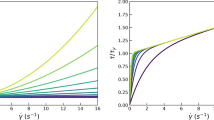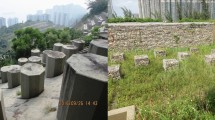Abstract
Massive debris flows or rock avalanches falling into a water reservoir may cause devastating hazards such as overtopping or dam breakage. This paper presents a coupled Computational Fluid Dynamics and Discrete Element Method (CFD-DEM) analysis on the impacting behaviour of a granular flow falling from an inclined slope into a water reservoir. The coupling between CFD and DEM considers such important fluid–particle interaction forces as the buoyancy force, the drag force and the virtual mass force. It is found that the presence of water in the reservoir can generally help to reduce direct impact of granular flow on the check dam behind the reservoir, minimizes the intense collisions and bouncing among particles and helps form a more homogeneous final deposited heap as compared to the dry case. While the interparticle/particle–wall frictions and collisions dominate the energy dissipation in the dry granular flow, the majority of kinetic energy of the granular system in the wet case is first transferred to the water body, which leaves the granular flow itself to become a contact-shearing dominant one and causes impulse wave travelling between the check dam and the slope surface for a rather sustained period before settling down. A power law distribution is found for the velocity profile of the granular flow travelling on both the slope and the reservoir ground surfaces, and it may change temporarily to a linear distribution at the transition point of the slope toe where the Savage number depicts a peak. The consideration of rolling friction among particles may homogeneously reduce the travelling velocity of the granular flow and alleviate the overall impact on the check dam. The impact on the check dam depends on both the initial debris releasing height and the reservoir water level. Medium water levels in the reservoir have been found to be generally safer when the initial debris height is relatively high.
Similar content being viewed by others
References
Ai J., Chen J.F., Rotter J.M., Ooi J.Y.: Assessment of rolling resistance models in discrete element simulations. Powder Technol. 206, 269–282 (2011)
Alexander D.: Urban landslides. Prog. Phys. Geogr. 13, 157–191 (1989)
Anderson T.B., Jackson R.: Fluid mechanical description of fluidized beds. Equations of motion. Ind. Eng. Chem. Fundam. 6, 527–539 (1967)
Bharadwaj R., Wassgren C., Zenit R.: The unsteady drag force on a cylinder immersed in a dilute granular flow. Phys. Fluids 16, 1511–1517 (2006)
Cates M.E., Wittmer J.P., Bouchaud J.P., Claudin P.: Jamming, force chains, and fragile matter. Phys. Rev. Lett. 81, 1841–1844 (1998)
Chen F., Drummb E.C., Guiochon G.: Coupled discrete element and finite volume solution of two classical soil mechanics problems. Comput. Geotech. 38, 638–647 (2011)
Chiou M.-C., Wang Y., Hutter K.: Influence of obstacles on rapid granular flows. Acta Mech. 175, 105–122 (2005)
Cundall P.A., Strack O.: A discrete numerical model for granular assemblies. Géotechnique 29, 47–65 (1979)
Datei, C.: Riproduzione su modello in scala 1:500 della franacadutanel 1959 entroillago-serbatoio del Maé, Internal Report, Univ. Of Padova, Padova, Italy (1968)
Di Felice R.: The voidage function for fluid–particle interaction systems. Int. J. Multiph. Flow 20, 153–159 (1994)
Deshpande S.S., Anumolu L., Trujillo M.F.: Evaluating the performance of the two-phase flow solver interFoam. Comput. Sci. Discov. 5, 014016 (2012)
Giachetti T., Paris R., Kelfoun K., Pérez-Torrado F.: Numerical modelling of the tsunami triggered by the Güìmar debris avalanche, Tenerife (Canary Islands): comparison with field-based data. Mar. Geol. 284, 189–202 (2011)
Goniva, C., Kloss, C., Hager, A., Pirker, S.: An open source CFD-DEM perspective. In: Proceedings of OpenFOAM Workshop, Göteborg, June 22–24 (2010)
Guo N., Zhao J.D.: The signature of shear-induced anisotropy in granular media. Comput. Geotech. 47, 1–15 (2013)
Hanes D.M., Walton O.R.: Simulations and physical measurements of glass spheres flowing down a bumpy incline. Powder Technol. 109, 133–144 (2000)
Heller V., Hager W.H., Minor H.E.: Scale effects in subaerial landslide generated impulse waves. Exp. Fluids 44, 691–703 (2008)
Heller V., Hager W.H.: Impulse product parameter in landslide generated impulse waves. J. Waterw. Port Coast. Ocean Eng. 136, 145–155 (2010)
Hürlimann M., Copons R., Altimir J.: Detailed debris flow hazard assessment in Andorra: a multidisciplinary approach. Geomorphology 78, 359–372 (2006)
Hutter K., Wang Y., Pudasaini S.P.: The Savage–Hutter avalanche model: how far can it be pushed?. Phil. Trans. R. Soc. A 363, 1507–1528 (2005)
Kafui K.D., Thornton C., Adams M.J.: Discrete particle-continuum fluid modelling of gas–solid fluidised beds. Chem. Eng. Sci. 57, 2395–2410 (2002)
Kloss, C., Goniva, C.: LIGGGHTS: a new open source discrete element simulation software. In: Proceedings 5th International Conference on Discrete Element Methods, London, UK, August (2010). (website: http://www.liggghts.com)
Knoll P., Mirazei S., Rodrigues M.: Interaction of a granular flow with a rectangular obstacle. Appl. Math. Model. 34, 407–414 (2010)
Lehning M., Doorschot J., Bartelt P.: A snowdrift index based on SNOWPACK model calculations. Ann. Glaciol. 31, 382–386 (2000)
Mohammed F., Fritz H.M.: Physical modelling of tsunamis generated by three-dimensional deformable granular landslides. J. Geophys. Res. 117, C11015 (2012)
Mollon G., Richefeu V., Villard D., Daudon D.: Numerical simulation of rock avalanches: Influence of a local dissipative contact model on the collective behavior of granular flows. J. Geophys. Res. 117, F02036 (2012)
Mollon G., Zhao J.D.: Fourier–Voronoi-based generation of realistic samples for discrete modeling of granular materials. Granul. Matter 14, 621–638 (2012)
Mollon G., Zhao J.D.: Generating realistic 3D sand particles using Fourier descriptors. Granul. Matter 15, 95–108 (2013)
Mollon G., Zhao J.D.: Characterization of fluctuations in granular hopper flow. Granul. Matter 15, 827–840 (2013)
Mollon, G., Zhao, J.D.: The influence of particle shape on granular Hopper flow. In: AIP Conference Proceedings 1542, 690-693 (2013)
Odar, F., Hamilton, W. S.: Forces on a sphere accelerating in a viscous fluid. J. Fluid Mech. 18, 302–314 (1964)
Odar, F., Hamilton, W. S.: Verification of the proposed equation for calculation of the forces on a sphere accelerating in a viscous fluid. J. Fluid Mech. 25, 591–592 (1966)
O’Sullivan, C.: Particulate Discrete Element Modelling: A Geomechanics Perspective. Spon Press (an imprint of Taylor and Francis), London (2011)
Panizzo A., De Girolamo P., Petaccia A.: Forecasting impulse wave generated by subaerial landslides. J. Geophys. Res. 110, C12025 (2005)
Phillips C.B., Martin R.L., Jerolmack D.: Impulse framework for unsteady flows reveals super-diffusive bed load transport. Geophys. Res. Lett. 40, 1328–1333 (2013)
Pitman E.B., de Long L.E.: A two-fluid model for avalanche and debris flows. Phil. Trans. R. Soc. A Math. Phys. Eng. Sci. 363, 1573–1601 (2005)
Pitman E.B., Le J.: A two-fluid model for avalanche and debris flows. Phil. Trans. R. Soc. A 363, 1573–1601 (2005)
Pudasaini S.P., Hutter K.: Rapid shear flows of dry granular masses down curved and twisted channels. J. Fluid Mech. 495, 193–208 (2003)
Pudasaini, S.P., Hutter, K.: Dynamics of rapid flows of dense granular avalanches. In: Avalanche Dynamics. Springer, Berlin (2007)
Sailer R., Fellin W., Fromm R., Jörg P., Rammer L., Sampl P., Schaffhauser A.: Snow avalanche mass-balance calculation and simulation-model verification. Ann. Glaciol. 48, 183–192 (2008)
Savage S.B.: The mechanics of rapid granular flows. Adv. Appl. Mech. 24, 289–366 (1984)
Snoeijer J.H., Vlugt T.J.H., van Hecke M., van Saarloos W.: Force network ensemble: a new approach to static granular matter. Phys. Rev. Lett. 92, 054302 (2004)
Suzuki K., Bardet J., Oda M., Iwashita K., Tsuji Y., Tanaka T., Kawaguchi T.: Simulation of upward seepage flow in a single column of spheres using discrete-element method with fluid–particle interaction. J. Geotech. Geoenviron. Eng. 133, 104–10 (2007)
Tang C., van Asch T.W.J., Chang M., Chen G.Q., Zhao X.H., Huang X.C.: Catastrophic debris flows on 13 August 2010 in the Qingping area, southwestern China. Geomorphology 139, 559–576 (2010)
Teufelsbauer H., Wang Y., Chiou M.C., Wu W.: Flow–obstacle interaction in rapid granular avalanches: DEM simulation and comparison with experiment. Granul. Matter 11, 209–220 (2009)
Tsuji Y., Kawaguchi T., Tanaka T.: Discrete particle simulation of two-dimensional fluidized bed. Powder Technol. 77, 79–87 (1993)
Tsuji Y., Tanaka T., Ishida T.: Lagrangian numerical simulation of plug flow of cohesionless particles in a horizontal pipe. Powder Technol. 71, 239–250 (1992)
Walder J.S., Watts P., Sorensen O.E., Janssen K.: Tsunamis generated by subaerial mass flows. J. Geophys. Res. 108, 2236 (2003)
Watt S.F.L., Talling P.J., Vardy M.E., Heller V., Hühnerbach V., Urlaub M., Sarkar S., Masson D.G., Henstock T.J., Minshull T.A.: Combinations of volcanic-flank and seafloor-sediment failure offshore Montserrat, and their implications for tsunami generation. Earth Planet. Sci. Lett. 319, 228–240 (2012)
Xu B.H., Feng Y.Q., Yu A.B., Chew S.J., Zulli P.: A numerical and experimental study of gas–solid flow in a fluid-bed reactor. Powder Handl. Process. 13, 71–76 (2001)
Xu B.H., Yu A.B.: Numerical simulation of the gas-solid flow in a fluidized bed by combining discrete particle method with computational fluid dynamics. Chem. Eng. Sci. 52, 2785–2809 (1997)
Zhao, J.D., Mollon, G.: A statistically-based approach on reconstructing sand particles for discrete modelling. In: Proceedings of the Workshop on Experimental Micromechanics for Geomaterials, Hong Kong (May 2013)
Zhao J.D., Shan T.: Coupled CFD-DEM simulation of fluid-particle interaction in geomechanics. Powder Technol. 239, 248–258 (2013)
Zhao J.D., Shan T.: Numerical modelling of fluid-particle interaction in granular media. Theor. Appl. Mech. Lett. 3(2), 021007 (2013)
Zhao, J.D., Shan, T.: A coupled CFD-DEM approach on modelling fluid-particle interactions in granular materials. Eng. Comput. Under review (2013)
Zhou G.D., Ng C.W.W.: Numerical investigation of reverse segregation in debris flows by DEM. Granul. Matter 12, 507–516 (2010)
Zhou C., Ooi J.Y.: Numerical investigation of progressive development of granular pile with spherical and non-spherical particles. Mech. Mater. 41, 707–714 (2009)
Zhou, Y.C., Wright, B.D., Yang, R.Y., Xu, B.H., Yu, A.B.: Rolling friction in the dynamic simulation of sandpile formation. Physica A 269, 536–553 (1999)
Zhu H.P., Zhou Z.Y., Yang R.Y., Yu A.B.: Discrete particle simulation of particulate systems: theoretical developments. Chem. Eng. Sci. 62, 3378–3396 (2007)
Zhu H.P., Zhou Z.Y., Yang R.Y., Yu A.B.: Discrete particle simulation of particulate systems: a review of major applications and findings. Chem. Eng. Sci. 63, 5728–5770 (2008)
Zuriguel, I., Mullin, T.: The role of particle shape on the stress distribution in a sandpile. Proc. R. Soc. Ser. A 464, 99–116 (2008)
Author information
Authors and Affiliations
Corresponding author
Additional information
Presented at the 8th European Solid Mechanics Conference in the Graz University of Technology, Austria, 9–13 July 2012.
Rights and permissions
About this article
Cite this article
Shan, T., Zhao, J. A coupled CFD-DEM analysis of granular flow impacting on a water reservoir. Acta Mech 225, 2449–2470 (2014). https://doi.org/10.1007/s00707-014-1119-z
Received:
Revised:
Published:
Issue Date:
DOI: https://doi.org/10.1007/s00707-014-1119-z




